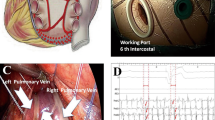Abstract
Purpose
We assessed conventional and reversed U curve methods for mapping and ablation of RVOT-type VAs.
Methods
Single-center data were reviewed from consecutive cases of symptomatic VAs of RVOT-type origin that were mapped and ablated successfully using conventional method in RVOT (pulmonary artery might be included) from January 2014 to December 2015 (cohort 1, n = 75) or conventional method in RVOT and reversed U curve in PSC (for first ablation attempt) from January 2016 to March 2017 (cohort 2, n = 60).
Results
At least 90% of RVOT-VAs could be eliminated using conventional method in RVOT or reversed U curve in PSC. For RVOT-VAs, if the earliest activation site was in midposterior free wall, midposterior septal side of RVOT, or anterior free wall/septal side of RVOT with conventional method, it was likely eliminated in right, left, and anterior PSC with reversed U curve method, respectively. Nearly the same earliest potential in almost the same region could be recorded by both methods. Compared with conventional method, the reversed U curve method showed better catheter stability and contact force during mapping and ablation, and showed distinctive features in presystolic potential recording, unipolar mapping, and ablation response.
Conclusions
Most of RVOT-VAs could be eliminated using conventional method in RVOT or reversed U curve in PSC. However, the reversed U curve method has superiority in catheter stability and contact force, especially for VAs form free wall of RVOT.





Similar content being viewed by others
References
Zhang J, Tang C, Zhang Y, Su X. Pulmonary sinus cusp mapping and ablation: a new concept and approach for idiopathic right ventricular outflow tract arrhythmias. Heart Rhythm. 2017
Liao Z, Zhan X, Wu S, Xue Y, Fang X, Liao H, et al. Idiopathic ventricular arrhythmias originating from the pulmonary sinus cusp: prevalence, electrocardiographic/electrophysiological characteristics, and catheter ablation. J Am Coll Cardiol. 2015;66:2633–44.
Yang Y, Liu Q, Liu Z, Zhou S. Treatment of pulmonary sinus cusp-derived ventricular arrhythmia with reversed U-curve catheter ablation. J Cardiovasc Electrophysiol. 2017;28:768–75.
Dixit S, Gerstenfeld EP, Callans DJ, et al. Electrocardiographic patterns of superior right ventricular outflow tract tachycardias: distinguishing septal and free-wall sites of origin. J Cardiovasc Electrophysiol. 2003;14:1–7.
Liu CF, Cheung JW, Thomas G, Ip JE, Markowitz SM, Lerman BB. Ubiquitous myocardial extensions into the pulmonary artery demonstrated by integrated intracardiac echocardiography and electroanatomic mapping: changing the paradigm of idiopathic right ventricular outflow tract arrhythmias. Circ Arrhythm Electrophysiol. 2014;7:691–700.
Acknowledgements
This study was supported by the National Natural Science Foundation of China (Grant Nos. 81700293 and 81100126).
Author information
Authors and Affiliations
Corresponding authors
Ethics declarations
Conflict of interest
The authors declare that they have no conflicts of interest.
Ethical approval
The study was approved by the institutional review board of Beijing Anzhen Hospital affiliated to Capital Medical University.
Informed consent
All patients were provided written informed consent.
Additional information
Zhuo Liang and Xuejun Ren are equal contributors.
Rights and permissions
About this article
Cite this article
Liang, Z., Ren, X., Zhang, T. et al. Mapping and ablation of RVOT-type arrhythmias: comparison between the conventional and reversed U curve methods. J Interv Card Electrophysiol 52, 19–30 (2018). https://doi.org/10.1007/s10840-018-0365-8
Received:
Accepted:
Published:
Issue Date:
DOI: https://doi.org/10.1007/s10840-018-0365-8




